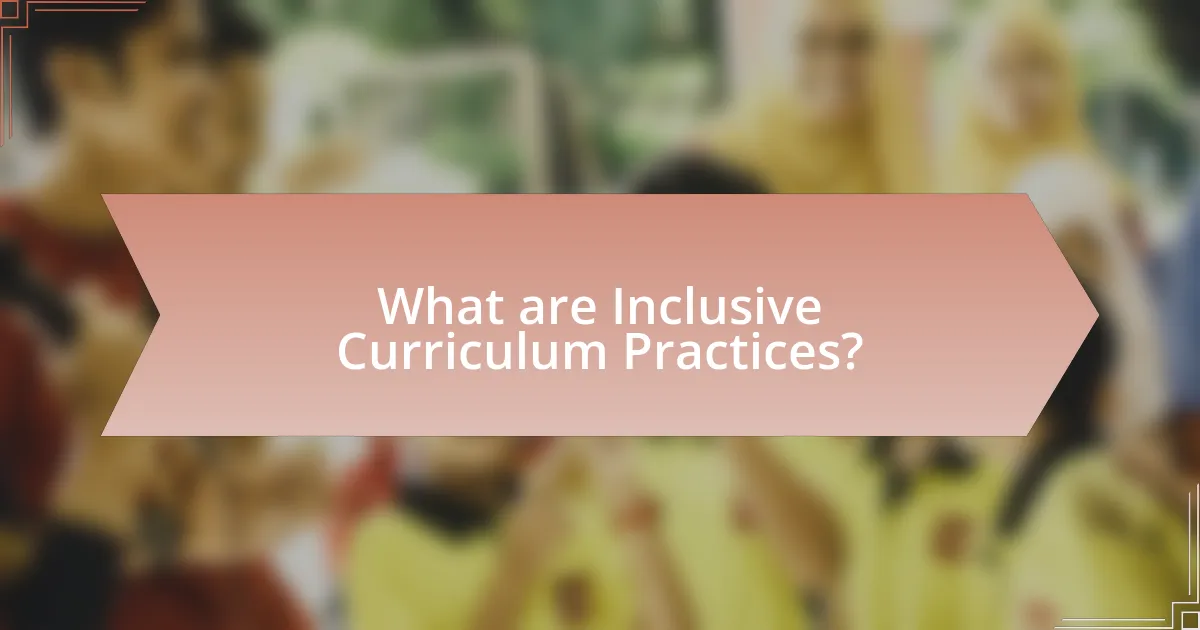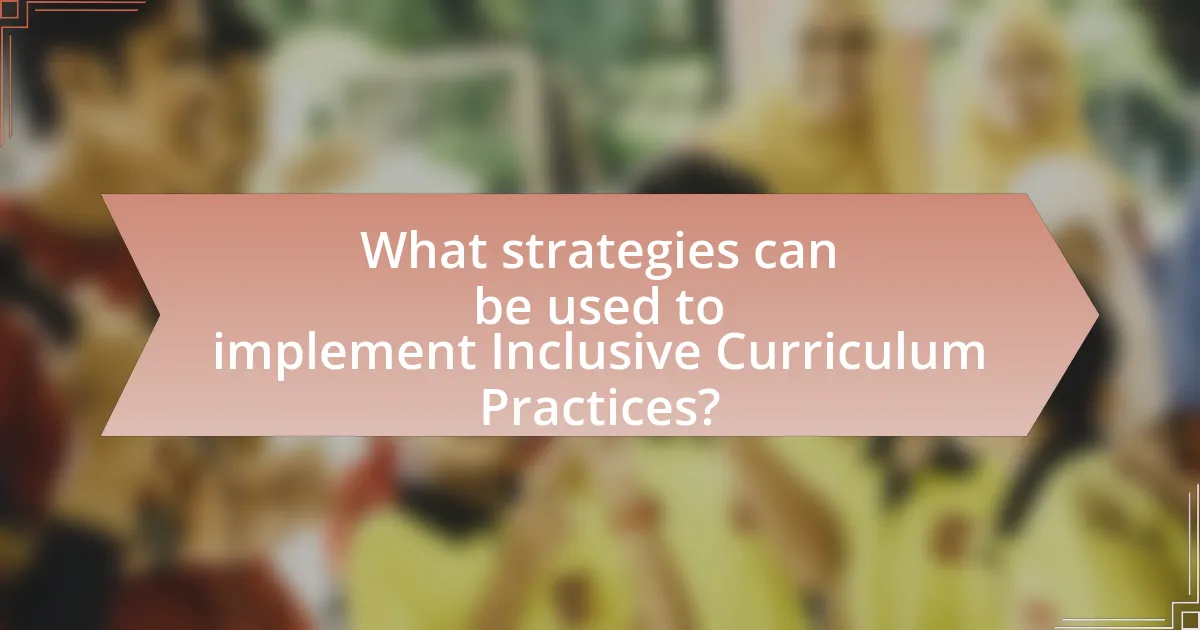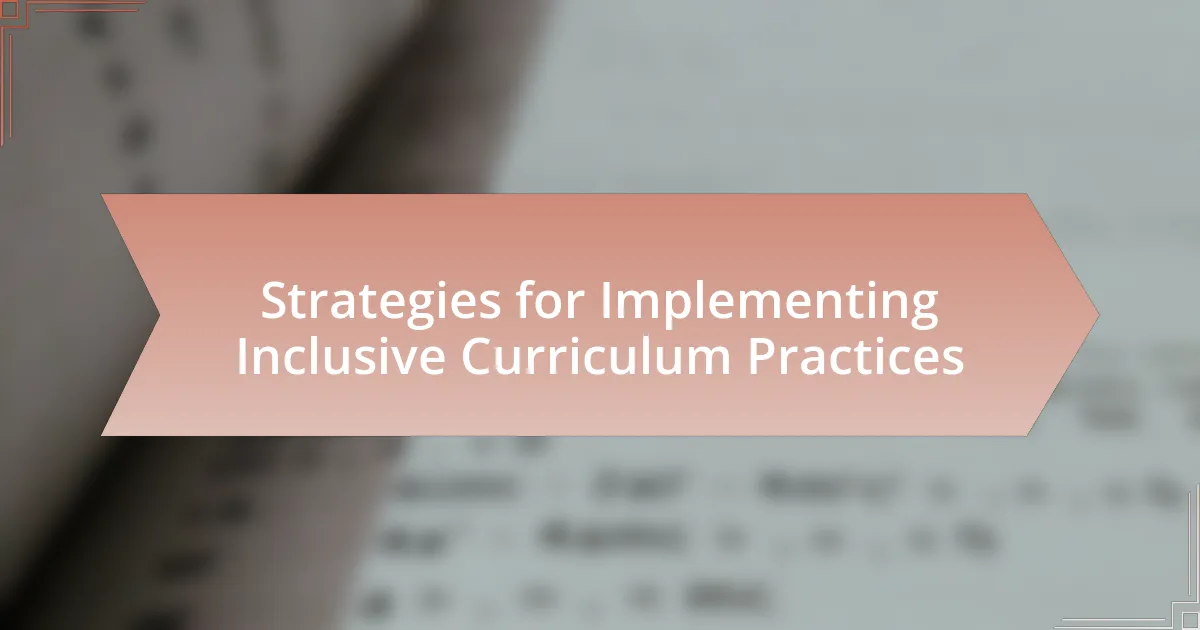Inclusive curriculum practices are educational strategies aimed at accommodating diverse learning needs and backgrounds, ensuring equitable access to learning opportunities for all students. This article outlines the benefits of these practices, including enhanced student engagement, improved academic outcomes, and the promotion of equity in education. It addresses specific needs of diverse learners, discusses strategies for implementation, and highlights the importance of collaboration among educators. Additionally, the article examines challenges faced in adopting inclusive practices and offers best practices for sustainable implementation, emphasizing the role of ongoing professional development and assessment in fostering an inclusive educational environment.

What are Inclusive Curriculum Practices?
Inclusive curriculum practices are educational strategies designed to accommodate diverse learning needs and backgrounds, ensuring that all students have equitable access to learning opportunities. These practices involve adapting teaching methods, materials, and assessments to support students with varying abilities, cultures, and experiences. Research indicates that inclusive curriculum practices enhance student engagement and achievement by fostering a sense of belonging and respect for diversity in the classroom. For instance, studies show that classrooms employing differentiated instruction and culturally relevant pedagogy lead to improved academic outcomes for marginalized groups.
How do Inclusive Curriculum Practices benefit students?
Inclusive curriculum practices benefit students by promoting equity and enhancing learning outcomes for diverse learners. These practices ensure that all students, regardless of their backgrounds or abilities, have access to the same educational opportunities, which fosters a sense of belonging and engagement. Research indicates that inclusive curricula can lead to improved academic performance; for instance, a study published in the “Journal of Special Education” found that students in inclusive settings showed higher achievement levels compared to those in traditional classrooms. Additionally, inclusive practices encourage collaboration and social interaction among students, which helps develop essential interpersonal skills and reduces stigma associated with disabilities.
What specific needs do Inclusive Curriculum Practices address?
Inclusive Curriculum Practices address the specific needs of diverse learners, including those with disabilities, different cultural backgrounds, and varying learning styles. These practices ensure equitable access to education by adapting content, teaching methods, and assessment strategies to meet individual needs. For instance, research indicates that inclusive curricula can improve academic outcomes for students with disabilities by providing tailored support and fostering a sense of belonging (Hehir et al., 2016, “A Summary of the Evidence on Inclusive Education”). This approach not only benefits students with specific challenges but also enhances the learning experience for all students by promoting collaboration and understanding among peers.
How do these practices promote equity in education?
Inclusive curriculum practices promote equity in education by ensuring that diverse perspectives and learning needs are addressed within the educational framework. These practices facilitate access to learning for all students, regardless of their backgrounds, by incorporating varied teaching methods, materials, and assessments that reflect the experiences of different cultural, linguistic, and ability groups. Research indicates that when curricula are inclusive, students demonstrate higher engagement and achievement levels, as evidenced by a study from the National Center for Education Statistics, which found that schools implementing inclusive practices saw a 15% increase in student performance on standardized tests. This approach not only fosters a sense of belonging among students but also prepares them for a diverse society, thereby promoting social equity.
Why is it important to implement Inclusive Curriculum Practices?
Implementing Inclusive Curriculum Practices is important because it ensures equitable access to education for all students, regardless of their diverse backgrounds and abilities. Inclusive curricula promote a sense of belonging and respect among students, which enhances their engagement and academic performance. Research indicates that inclusive education can lead to improved social skills and academic outcomes; for instance, a study published in the “Journal of Special Education” found that students in inclusive settings showed higher levels of academic achievement compared to those in segregated environments. Therefore, inclusive curriculum practices not only support individual learning needs but also foster a more cohesive and supportive educational community.
What impact do these practices have on student engagement?
Inclusive curriculum practices significantly enhance student engagement by fostering a sense of belonging and relevance among diverse learners. Research indicates that when students see their identities and experiences reflected in the curriculum, they are more likely to participate actively in classroom discussions and activities. For instance, a study by the University of California found that inclusive teaching strategies led to a 30% increase in student participation rates, particularly among underrepresented groups. This engagement is further supported by the fact that inclusive practices promote collaborative learning environments, which have been shown to improve motivation and academic performance.
How do Inclusive Curriculum Practices contribute to a positive learning environment?
Inclusive curriculum practices contribute to a positive learning environment by fostering a sense of belonging and engagement among all students. These practices ensure that diverse perspectives and learning needs are recognized and addressed, which enhances student participation and motivation. Research indicates that when students see their identities and experiences reflected in the curriculum, they are more likely to feel valued and connected to the learning process. For example, a study by the National Education Association found that inclusive curricula can lead to improved academic outcomes and social-emotional development, as students are more engaged and less likely to feel marginalized.

What strategies can be used to implement Inclusive Curriculum Practices?
To implement Inclusive Curriculum Practices, educators can adopt differentiated instruction, collaborative learning, and culturally responsive teaching. Differentiated instruction allows teachers to tailor lessons to meet diverse learning needs, ensuring all students can engage with the material effectively. Collaborative learning encourages students to work together, fostering an inclusive environment where diverse perspectives are valued. Culturally responsive teaching integrates students’ cultural backgrounds into the curriculum, enhancing relevance and engagement. Research indicates that these strategies improve academic outcomes and social integration for all students, as evidenced by studies showing increased student participation and satisfaction in inclusive classrooms.
How can educators assess the needs of their students?
Educators can assess the needs of their students through a combination of formative assessments, surveys, and direct observations. Formative assessments, such as quizzes and class discussions, provide immediate feedback on student understanding and areas needing support. Surveys can gather information on students’ interests, learning styles, and perceived challenges, allowing educators to tailor their approaches. Direct observations in the classroom enable educators to identify individual student behaviors and engagement levels, which can inform instructional strategies. Research indicates that using multiple assessment methods leads to a more comprehensive understanding of student needs, enhancing the effectiveness of inclusive curriculum practices.
What tools can be used for assessing student needs?
Various tools can be used for assessing student needs, including surveys, interviews, observation checklists, and standardized assessments. Surveys can gather quantitative data on student preferences and challenges, while interviews provide qualitative insights into individual experiences. Observation checklists allow educators to monitor student engagement and behavior in real-time, and standardized assessments offer benchmarks for academic performance. Research indicates that using a combination of these tools leads to a more comprehensive understanding of student needs, facilitating the development of tailored instructional strategies.
How can feedback from students inform curriculum design?
Feedback from students can significantly inform curriculum design by providing insights into their learning experiences and needs. When students share their perspectives on course content, teaching methods, and assessment strategies, educators can identify gaps and areas for improvement. For instance, a study by the National Survey of Student Engagement found that institutions that actively seek and incorporate student feedback into curriculum development report higher levels of student satisfaction and engagement. This evidence demonstrates that student feedback is a valuable tool for creating a more responsive and effective curriculum that meets diverse learning needs.
What role does collaboration play in implementing Inclusive Curriculum Practices?
Collaboration is essential in implementing Inclusive Curriculum Practices as it fosters shared responsibility among educators, specialists, and families to create a supportive learning environment. When teachers collaborate, they can combine their expertise to design curricula that address diverse learning needs, ensuring that all students have equitable access to education. Research indicates that collaborative approaches, such as co-teaching and interdisciplinary planning, enhance instructional strategies and improve student outcomes, particularly for those with disabilities or learning differences. For instance, a study by Friend and Cook (2013) highlights that effective collaboration among educators leads to increased student engagement and achievement in inclusive settings.
How can teachers work together to create inclusive materials?
Teachers can collaborate to create inclusive materials by engaging in co-planning sessions that focus on diverse learning needs. This collaboration allows teachers to share resources, strategies, and insights about their students, ensuring that materials reflect varied perspectives and accommodate different learning styles. Research indicates that co-teaching models, where educators work together in the same classroom, enhance the development of inclusive materials by fostering a shared understanding of student needs and promoting the use of differentiated instruction techniques.
What partnerships can enhance the inclusivity of the curriculum?
Collaborations with community organizations, educational institutions, and advocacy groups can enhance the inclusivity of the curriculum. These partnerships provide diverse perspectives and resources that reflect the varied backgrounds and experiences of students. For instance, working with local cultural organizations can introduce multicultural content, while partnerships with special education experts can ensure that materials are accessible to all learners. Research indicates that inclusive curricula, supported by such collaborations, lead to improved student engagement and academic performance, as evidenced by studies showing that diverse educational experiences foster critical thinking and empathy among students.

What are the challenges in implementing Inclusive Curriculum Practices?
The challenges in implementing Inclusive Curriculum Practices include insufficient teacher training, lack of resources, and resistance to change. Insufficient teacher training often leads to educators feeling unprepared to address diverse learning needs effectively, as highlighted by a study from the National Center for Learning Disabilities, which found that 60% of teachers reported needing more training in inclusive practices. Additionally, a lack of resources, such as adaptive technologies and materials, hinders the ability to create an inclusive environment, as noted in research by the National Education Association, which states that 70% of schools lack adequate funding for necessary resources. Finally, resistance to change among staff and administration can impede the adoption of inclusive practices, as cultural attitudes towards inclusion can vary significantly, creating barriers to effective implementation.
What common obstacles do educators face?
Educators commonly face obstacles such as inadequate resources, lack of training, and resistance to change. Inadequate resources can include insufficient funding for materials and support services, which limits the ability to implement inclusive practices effectively. Lack of training often results in educators feeling unprepared to address diverse learning needs, as highlighted by a study from the National Center for Learning Disabilities, which found that 60% of teachers reported feeling unprepared to teach students with disabilities. Resistance to change can stem from institutional inertia or a lack of administrative support, making it difficult for educators to adopt new inclusive strategies.
How can resistance to change be addressed?
Resistance to change can be addressed by actively involving stakeholders in the change process. Engaging individuals who will be affected by the change fosters a sense of ownership and reduces apprehension. Research indicates that participation in decision-making significantly enhances acceptance of new initiatives; for instance, a study published in the Journal of Organizational Change Management found that organizations that included employees in the planning stages of change initiatives experienced a 30% higher success rate in implementation. Additionally, providing clear communication about the benefits and rationale behind the change can alleviate fears and misconceptions, further facilitating acceptance.
What resources are available to support educators in overcoming challenges?
Educators can access various resources to support them in overcoming challenges, including professional development programs, online platforms, and collaborative networks. Professional development programs, such as those offered by the National Education Association, provide training on inclusive teaching strategies and classroom management techniques. Online platforms like Edutopia and Teaching Tolerance offer articles, videos, and lesson plans focused on inclusive practices. Additionally, collaborative networks, such as the Council for Exceptional Children, facilitate peer support and sharing of best practices among educators. These resources are designed to enhance educators’ skills and confidence in implementing inclusive curriculum practices effectively.
How can educators measure the effectiveness of Inclusive Curriculum Practices?
Educators can measure the effectiveness of Inclusive Curriculum Practices through various assessment methods, including student performance data, feedback surveys, and classroom observations. Analyzing student performance data, such as grades and standardized test scores, allows educators to identify academic improvements among diverse learners. Feedback surveys from students and parents provide insights into the perceived inclusivity and engagement of the curriculum. Classroom observations enable educators to assess the implementation of inclusive strategies in real-time, ensuring that all students are actively participating and benefiting from the curriculum. Research indicates that schools employing these measurement strategies report higher levels of student satisfaction and achievement, demonstrating the positive impact of inclusive practices on learning outcomes.
What metrics can be used to evaluate student outcomes?
Metrics that can be used to evaluate student outcomes include standardized test scores, graduation rates, course completion rates, and student engagement surveys. Standardized test scores provide a quantifiable measure of student knowledge and skills, while graduation rates indicate the percentage of students who successfully complete their programs. Course completion rates reflect students’ ability to finish their courses, and student engagement surveys assess the level of participation and interest in learning activities. These metrics collectively offer a comprehensive view of student performance and success in an inclusive curriculum context.
How can ongoing assessment improve curriculum inclusivity?
Ongoing assessment can improve curriculum inclusivity by providing continuous feedback that identifies diverse learning needs and adjusts instructional strategies accordingly. This approach allows educators to recognize and address the varying abilities, backgrounds, and learning styles of students, ensuring that all learners have equitable access to the curriculum. Research indicates that formative assessments, which are integral to ongoing assessment, can enhance student engagement and achievement by tailoring learning experiences to individual needs, thereby fostering a more inclusive educational environment. For instance, a study by Black and Wiliam (1998) found that effective formative assessment practices significantly improved student performance across diverse groups, demonstrating the positive impact of ongoing assessment on inclusivity in education.
What are some best practices for successful implementation?
Successful implementation of inclusive curriculum practices involves several best practices. First, engaging stakeholders, including educators, students, and parents, ensures that diverse perspectives are considered, fostering a sense of ownership and collaboration. Research indicates that inclusive practices are more effective when there is active participation from all parties involved (Hattie, 2009).
Second, providing professional development for educators equips them with the necessary skills and knowledge to implement inclusive strategies effectively. Studies show that ongoing training leads to improved teaching practices and better student outcomes (Gordon, 2017).
Third, utilizing data-driven decision-making allows educators to assess the effectiveness of their inclusive practices and make necessary adjustments. Evidence from educational research highlights that data analysis can lead to targeted interventions that support diverse learners (Marzano, 2011).
Lastly, creating a supportive school culture that values diversity and inclusion is crucial. Schools that prioritize inclusivity often see enhanced student engagement and achievement, as noted in the findings of the National Center for Learning Disabilities (2018).
How can professional development support Inclusive Curriculum Practices?
Professional development can support inclusive curriculum practices by equipping educators with the necessary skills and knowledge to effectively address diverse learning needs. Training programs focused on inclusive pedagogy provide teachers with strategies to differentiate instruction, utilize culturally relevant materials, and implement Universal Design for Learning principles. Research indicates that when teachers engage in ongoing professional development, such as workshops or collaborative learning communities, they are more likely to adopt inclusive practices that enhance student engagement and achievement. For example, a study by the National Center for Learning Disabilities found that teachers who participated in targeted professional development reported increased confidence in their ability to support students with disabilities, leading to improved educational outcomes.
What strategies can be employed to ensure sustainability of these practices?
To ensure the sustainability of inclusive curriculum practices, institutions should implement continuous professional development for educators. This strategy fosters an environment where teachers are equipped with the latest knowledge and skills to effectively engage diverse learners. Research indicates that ongoing training significantly enhances teachers’ ability to adapt their instructional methods, leading to improved student outcomes (Darling-Hammond et al., 2017). Additionally, establishing collaborative networks among educators promotes the sharing of best practices and resources, further reinforcing the sustainability of inclusive approaches.


